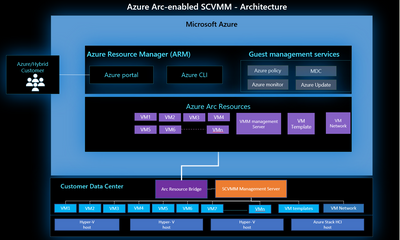Hybrid VM Management with Azure Arc-enabled System Center VMM

As customers continue to leverage Microsoft Azure to build, deploy, and manage business critical applications at scale, hybrid cloud is quickly becoming their mainstay. Customers have been telling us that a consistent experience of managing and securing their diverse IT environments will be key as they scale their cloud-native applications and infrastructure.
To enable the flexibility and agility customers are seeking, we introduced Azure Arc – a set of technologies that extends the Azure platform so you can build applications and services with the flexibility to run across datacenters, edge, and multicloud environments.
Azure Arc enables customers to secure and govern their physical or virtual infrastructure and Kubernetes clusters anywhere using familiar Azure Management practices. Customers can also build cloud-native applications with Azure application services and Azure data services on their existing infrastructure in their datacenters, at the edge or in multicloud environments.
Today, our customers use System Center Virtual Machine Manager (SCVMM) at scale to manage and operate hundreds of physical Servers and tens of thousands of virtual machines on-premises, along with their Azure deployments. We want to ensure that these workloads can also benefit from ongoing innovations in Azure.
Extending Azure Arc to System Center Virtual Machine Manager (SCVMM)
Azure Arc-enabled System Center VMM is a new Azure Arc capability, now available in Preview. This enables on-premises System Center VMM environments to be connected to Azure, unlocking Azure-based self-service for end users and developers.
With this, Virtual Machines can now be created, managed and deleted in System Center VMM deployments on-premises through familiar Azure Portal experiences. In addition, end users will be able to deploy and manage VMs in SCVMM using ARM templates, ensuring that they can deploy Infrastructure as Code consistently across Azure and on-premises environments. With ARM templates, DevOps teams can also use CI/CD pipelines to provision or update the VMs along with application updates.
With this integration, IT administrators can now extend the Azure Portal to provide the end users and developers with a familiar and consistent Self-service experience to their VMs and associated resources similar to Azure. In addition, administrators can govern and drive compliance through the rich Azure governance controls and Azure RBAC for the self-service users.
Onboarding SCVMM to Azure Arc:
To onboard SCVMM to Azure Arc, administrators would require deploying a virtual appliance called the Arc Resource Bridge. The Arc resource Bridge acts as a gateway connecting the System Center Virtual Machine Manager and Azure. The Resource Bridge hosts the necessary agents and extensions required to communicate to Azure and provide the required representation of the SCVMM resources on Azure.
Once the Resource Bridge is operational and connected to Azure, the SCVMM Management Server, the Virtual Machines, VM Networks and other resources are represented and visible in Azure Arc and can be used by customers for operations on their VM and managing their lifecycle.
Get started now
We are very excited to have you try Arc-enabled SCVMM and its capabilities. Please signup here if you would like to receive further updates on Arc-enabled SCVMM.
More information on onboarding and using Arc-enabled SCVMM can be found below:
Overview of Azure Arc-enabled System Center VMM
Connect an SCVMM Management Server to Azure Arc
Create a virtual machine on SCVMM from Azure Arc
Published on:
Learn moreRelated posts
Azure Developer CLI (azd) Nov 2025 – Container Apps (GA), Layered Provisioning (Beta), Extension Framework, and Aspire 13
This post announces the November release of the Azure Developer CLI (`azd`). The post Azure Developer CLI (azd) Nov 2025 – Container App...
Announced at Ignite 2025: Azure DocumentDB, MCP Toolkit, Fleet Analytics, and more!
Microsoft Ignite 2025 kicked off with a wave of announcements for Azure Cosmos DB and Azure DocumentDB, setting the tone for a week of innovat...
Automating Microsoft Fabric Workspace Creation with Azure DevOps Pipelines
In today’s fast-paced analytics landscape, Microsoft Fabric has become the leader of enterprise BI implementations, one of the fundamental con...
New T-SQL AI Features are now in Public Preview for Azure SQL and SQL database in Microsoft Fabric
At the start of this year, we released a new set of T-SQL AI features for embedding your relational data for AI applications. Today, we have b...
Zonal resiliency in Azure
Azure DevOps and GitHub Repositories — Next Steps in the Path to Agentic AI
In May, we talked about the evolution of GitHub Copilot from a coding assistant into an AI powered peer programmer. Since then, GitHub has tak...
Public preview of vector indexing in Azure SQL DB, Azure SQL MI, and SQL database in Microsoft Fabric
We are happy to share that DiskANN vector indexing is now in public preview across Azure SQL Database, Azure SQL Managed Instance, and SQL dat...





